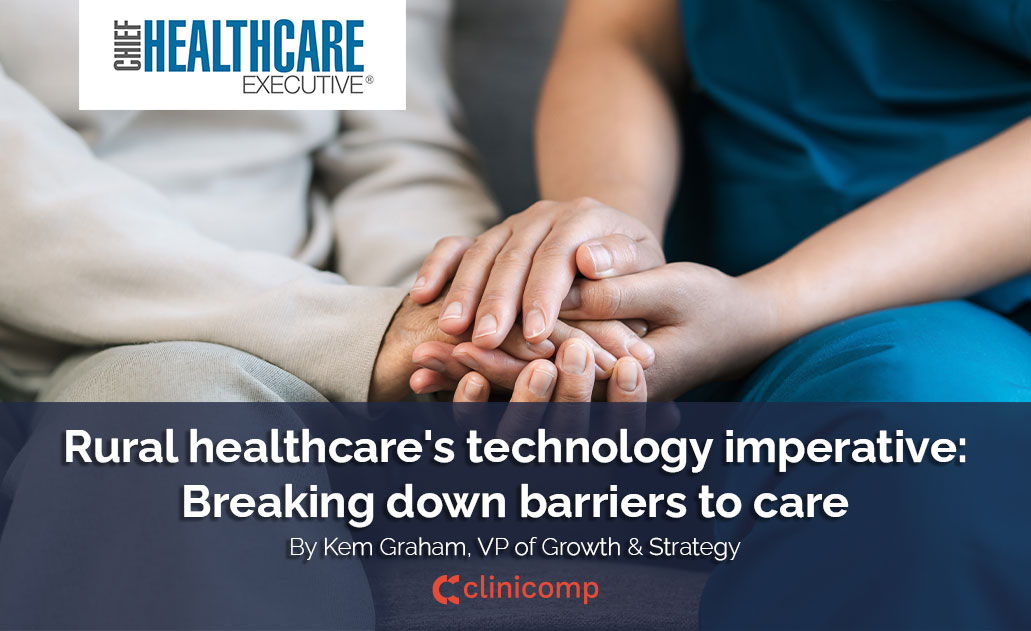April 14th, 2025 / News
Rural healthcare’s technology imperative: Breaking down barriers to care

The crisis in rural healthcare has reached a critical point, with more than 700 rural hospitals – over 30% of all such providers in the country – at risk of closing.
Even more alarming, 360 facilities face immediate risk of closure within the next two to three years due to severe financial problems. And fewer than half of rural hospitals today provide maternity care. While the conversation around rural healthcare access has intensified over the past year, the underlying challenges continue to threaten these essential providers.
The causes are complex and interconnected. Rural hospitals face inadequate payments from private health plans that fail to cover the higher costs of care in rural communities. While the United States attracts patients from around the world for its exceptional medical care, many rural Americans struggle to access basic services as their local facilities fight for survival. This disparity isn’t just about proximity to healthcare facilities –– it’s increasingly about the technology infrastructure that enables modern healthcare delivery.
The fundamental truth is that access to world-class healthcare shouldn’t depend on geography. Rural Americans deserve the same quality of care as their urban counterparts, yet the technological divide continues to widen this gap in healthcare equity.
Technology at the crossroads
The challenges facing rural healthcare providers are multifaceted. Many facilities operate on razor-thin margins, or even in the red, making major technology investments seem unattainable.
Some rural hospitals still rely on paper records, creating a daunting gap between their current operations and modern healthcare delivery standards. The decision to maintain independence versus joining larger health systems often hinges on these technological and financial pressures.
Interoperability –– the ability to share and access patient information across different healthcare providers and systems –– represents a particular challenge.
While telehealth has emerged as one solution for expanding access to specialists, it is only part of the equation. Effective patient care requires access to complete medical histories, including historical data and imaging. A comprehensive view of patient information goes far beyond what can be accomplished through telehealth consultations and paper records alone.
Breaking down implementation barriers
Rural healthcare facilities face several significant barriers when implementing modern technology systems.
The traditional upfront implementation costs can be prohibitive for facilities operating on strained margins. Many rural hospitals operate with minimal IT staff –– sometimes a single person handling multiple responsibilities –– making it difficult to maintain sophisticated systems.
The complexity of these systems, coupled with ongoing service and support expenses, creates a seemingly insurmountable challenge for many rural providers.
A new era on the horizon
However, the market is evolving in response to these challenges. A new era of technology has emerged that aligns with the unique challenges rural healthcare providers face.
This modern solution features sustainable pricing models and simplified maintenance requirements tailored to the financial and operational realities of smaller facilities. By emphasizing adaptability to existing systems and workflows, they make implementation feasible without requiring extensive IT resources or compromising autonomy.
User-friendly interfaces, AI, robust support and secure, dependable uptime ensures these solutions are manageable and practical for facilities with limited staff, enabling them to deliver data-driven care that enhances patient outcomes.
The impact of technology gaps extends beyond individual facilities which affect the entire healthcare system. When rural healthcare providers lack access to a modern, adaptable technology infrastructure, it weakens the entire American healthcare network. The consequences of allowing rural healthcare to flounder will eventually ripple through the system, affecting healthcare delivery across all settings.
The path forward requires increased market awareness of affordable options that allow rural healthcare providers to maintain their independence, supported by world-class technology, while delivering exceptional care. Unlike traditional systems that might require dozens of new hires just for implementation and maintenance, modern solutions can be supported with existing staff levels while still providing comprehensive patient data access and supporting provider autonomy.
A better path forward
The technology gap in rural healthcare isn’t just a technology problem –– it’s a health equity issue. Whether by birth or choice, rural Americans deserve the same quality of care as their urban counterparts. With emerging affordable technology options, that goal is becoming achievable.
The financial pressure to modernize technology systems compounds these existing challenges. Rural hospitals caught between inadequate reimbursement rates and the need to invest in modern healthcare infrastructure face an almost impossible choice: maintain outdated systems and risk falling further behind or attempt costly upgrades that may push them closer to closure. This dynamic makes affordable, manageable solutions not just desirable but essential for rural healthcare survival.
The focus on rural healthcare technology access comes at a crucial time. As this vital healthcare segment looks to more affordable and attainable solutions in the market, rural healthcare providers have new opportunities to deliver the comprehensive, data-driven care their communities need and deserve.
